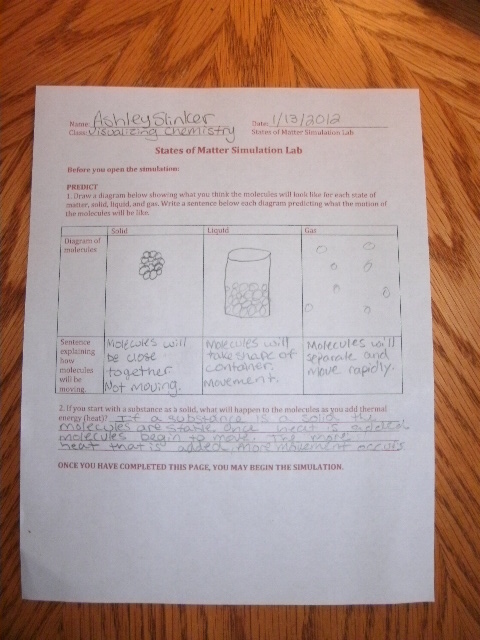Convert to Kelvin
0°F = 255.222 K
32°F = 273 K
70°F = 294.111 K
212°F = 373 K
Complete the Teaching Idea: States of Matter Simulation Lab by Kelly Vaughan. Complete the lab worksheet as if you were a student, and then post this on your blog. Take a picture of it.
page 1
page 2
page 3
page 4
In the States of Matter simulation, choose the Solid, Liquid, and Gas Tab at the top of the screen. Choose the water molecule and cool the water to 0 K. Describe how the water molecules are aligned and attracted to each other. Which atoms are attracted to which other atoms?
Every water molecule in the simulation is touching another water molecule. The molecules stay connected to one another and move back and forth slowly. A water molecule is made up of two hydrogen atoms and one oxygen atom. The oxygen (negative charge) atoms are attracted to the hydrogen (positive charge) atoms of other molecules. The molecules arrange themselves when a positive charged hydrogen atom can attach to a negative charged oxygen atom. Therefore molecules arrange themselves based on their charges (opposites attract).
Switch to the Phase Changes Tab on the States of Matter simulation. Notice how on the bottom right there is a small red dot that indicates where the system is at as far as temperature, pressure and state of matter. Play with the simulation to notice changes, notice that when you push down the pressure can go way up and explode the box. On your blog, report a temperature and pressure required to make oxygen a liquid. This is sometimes how the oxygen exists in pressurized oxygen tanks, perhaps like ones you may use to go diving.
In order to make oxygen a liquid I increased the pressure to 51.18 ATM and this made the temperature of oxygen increase to 74 K. I also (to make oxygen a liquid) increased the temperature of the oxygen to 385 K and this made the pressure increase to 12 ATM.
List and describe at least two Science Standards that this activity addresses.
A.4.3 When investigating a science-related problem, decide what data can be collected to determine the most useful explanations.
B.4.1 Use encyclopedias, source books, texts, computers, teachers, parents, other adults, journals, popular press, and various other sources, to help answer science-related questions and plan investigations.
D.4.3. Understand that substances can exist in different states - solid, liquid, gas.
D.4.4 Observe and describe changes in form, temperature, color, speed, and direction of objects and construct explanations for the changes.
D.4.5 Construct simple models of what is happening to materials and substances undergoing change, using simple instruments or tools to aid observations and collect data.




No comments:
Post a Comment